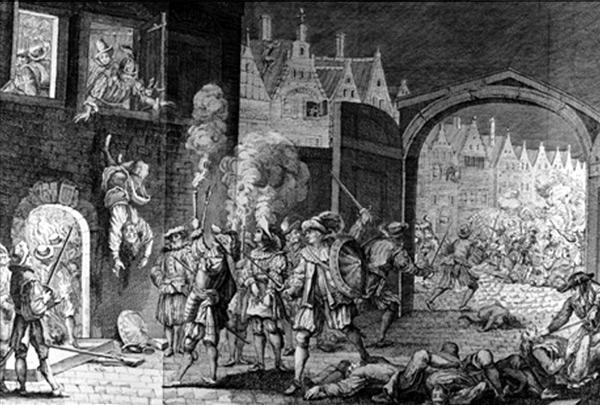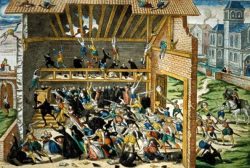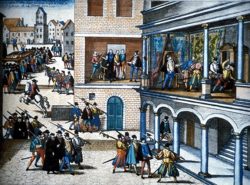First war of Religion (1562-1563)
War times1 March 1562 Massacre of Wassy
2 April 1562 Orléans conquered by Louis de Condé
30 April 1562 Lyon becomes Reformed, violence, iconoclasm
20 September 1562 Treaty of Hampton Court between Louis de Condé and Elizabeth I of England
October 1562 Rouen conquered by the partisans of King Francis II, death of Antoine de Bourbon
19 December 1562 Victory of the Royal troops at the battle in Dreux, Louis de Condé made prisoner
28 February 1563 Assassination of François de Guise
19 March 1563 Edict of pacification of Amboise
The beginnings of hostilities
The killing of a hundred Protestants during worship in a barn near the town of Wassy by the Duke François de Guise on 1 March 1562, was considered as the triggering event of the first war of religion.
Louis de Bourbon, prince of Condé, was the soul and organizer of the war. At his call the Protestants took up arms, cities were the favoured targets of both sides. Louis de Condé took over Orléans on 2 April, and then Rouen – the second largest city in France. In the night of 30 April 1562, Lyon turned to the Reformation. Other cities were as quickly taken as lost, such as Rouen and many Loire valley cities.
Louis de Condé justified «taking up arms» by the need to «protect the young king from those around him under the queen mother’s government.» He denounced ambitious courtisans who disobeyed the edicts of pacification and killed «a number of poor subjects gathered to pray and serve God, as the edicts permitted, sparing neither age nor gender.»
The war spread through the kingdom especially in three areas: Normandy and the Loire valley, South-west, mainly South-east, the Languedoc region was almost totally left to the Protestants. It was characterised by extreme violence on both sides. The best known deeds were done on the Protestant side by François de Beaumont, baron des Adrets in the Dauphiné and Provence regions, on the Catholic side by Blaise de Montluc in the Guyenne region.
The involvement of foreign forces complicated matters. Duke François de Guise called on Philippe II of Spain – who had married Henri II’s eldest daughter- and on the Duc de Savoie. The Protestants counted on the German soldiers but mostly on the British forces. In the Hampton Court Treaty signed in September 1562, Queen Elizabeth I gave money and 6,000 soldiers, Le Havre was taken as pledge, and Calais was promised in case of a victory.
The Catholic leaders took the initiative. François de Guise and constable Anne de Montmorency beseiged Rouen, the city was taken and submitted to looting and extreme violence. Antoine de Bourbon was injured, and confirmed that he was a Protestant before he died. The battle of Dreux on 19 December 1562 confronted the troops of Louis de Condé and those of constable Anne de Montmorency, was particularly bloody with 8,000 casualties. The royal forces took the advantage, and Louis de Condé was captured. Duke François de Guise then besieged Orléans which was in the hands of the Protestants. On 18 February 1563 he was killed by Jean de Poltrot de Méré, a former plotter in Amboise. The latter, while tortured on the Place de Grève in Paris, blamed Admiral Gaspard de Coligny.
Catherine de Medici, freed from the de Guise control, decided to put an end to the massacres, and to negotiate with the Protestants while keeping them within tolerable limits for the Catholics. On 19 March 1563 the edict of Pacification, negotiated by Louis de Condé and constable Anne de Montmorency, was signed at Amboise. The provisions of the agreement were to be implemented until the meeting of a national council. Freedom of conscience for all subjects was acknowledged, but the edict was less favourable to the Protestants than the former edict of January 1562. Worshipping was indeed authorised in the castles – for the lord, his family, his servants- but was granted by bailiwick to «ordinary» people in the neighbouring districts establishing a social discrimination that would distance people from Protestantism. Worshipping was forbidden in Paris. The «peace of princes» was condemned by Calvin who accused them of treason, limiting Protestantism to the aristocracy, and sacrificing popular Protestantism. The Huguenot party had lost the battle, the spread of the Reformation was halted.
The reconciliation between Catholics and Protestants was finalised during the campaign against le Havre. The once enemies Louis de Condé and constable Anne de Montmorency, fought the English who were defeated in July. The peace with England was signed in the city of Troyes in April 1564.
The people found it hard to accept the edict of pacification at Amboise
Peaceful coexistence was encouraged by the authorities who sent commissioners from the parliament to receive complaints, to return property on both sides, and the banning of carrying arms. In some cities such as Lyon, Orléans or Castres, both confessions were on equal terms. Reinstating confidence and restoring prosperity were the main goals, but neither the Protestants nor the Catholics approved of the edict. Several parliaments refused to record it. Some thought that tolerance could not be consistent with the principle monarchy. Protestant troops still ruled over a large part of the kingdom, notably in Normandy, Languedoc and Dauphiné regions. For many the «pacification» could not last.
Progress in the tour
Bibliography
- Books
- COTTRET Bernard, 1598, L’édit de Nantes, Perrin, Paris, 1997
- GARRISSON Janine, Henri IV, Le Seuil, rééd. 2008, Paris, 1984
- MIQUEL Pierre, Les Guerres de religion, Fayard, Paris, 1980
Associated tours
-

The eight wars of religion in detail
The wars lasted thirty-six years. The kingdom of France had 18 million inhabitants at that time – indeed, few other European countries had as many. The growth rate rose considerably...





